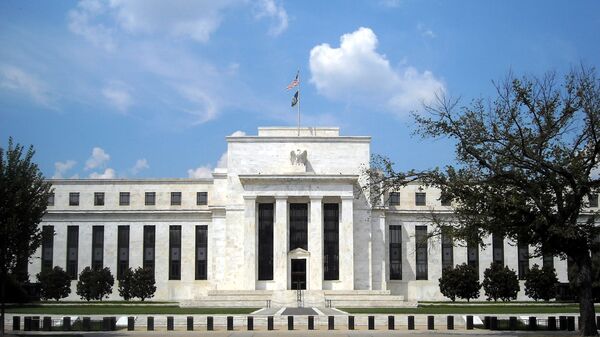Kristian Rouz – US central bankers are pushing back on pressure from the White House, as well as growing market anticipation, to cut base borrowing costs by as much as 0.5 per cent at the Fed's next policy meeting in July. Fed officials have reaffirmed independence of the central bank, saying its policy remains data-dependent – which doesn't mean rates couldn't go down soon.
In a speech at the Council on Foreign Relations in New York on Tuesday, Fed Chairman Jerome Powell said the Fed doesn't base its policies on market expectations or political pressure from the administration.
Powell signalled that the course of US monetary policies – including interest rates, bond purchases, and other tools – still largely depends on the incoming macroeconomic data, but didn't explicitly rule out possible easing due to rising trade risks and a global economic slowdown.
Fed Chair Powell opened his speech Tuesday with this statement defending the Fed's independence https://t.co/hyi6XpYY3T pic.twitter.com/7fVTSaR1qh
— Nick Timiraos (@NickTimiraos) 25 июня 2019 г.
“The Fed is insulated from short-term political pressures”, Powell said. “We’re not in the business, really, of trying to work through short-term movements in financial conditions. We have to look through that.”
The Fed chair said the recent round of escalation in trade tensions with China has produced a degree of uncertainty over the future of bilateral trade and a possible trade agreement. Powell admitted US inflation rates also remain slow, which might be holding back the broader GDP growth rate.
Last week, the Federal Open Markets Committee (FOMC) kept interest rates within the gauge of 2.25-2.5 per cent, saying US economic growth remains solid and sustainable, and the current level of borrowing costs doesn't appear to weigh on GDP expansion.
Meanwhile, some experts are saying that US rates are still below the so-called 'neutral rate' – estimated at roughly 3 per cent and Fed policy is still accommodative and supportive of economic growth through ongoing credit expansion.
The Fed has recently downgraded its estimate of a neutral rate down to 2.5 per cent – suggesting its current policies aren't supporting or stifling the pace of GDP growth.
Fed lowers estimate of neutral rate - https://t.co/rI1fs880tS pic.twitter.com/wDTkIfYx0K
— Nareit (@REITs_Nareit) 25 июня 2019 г.
Total US household debt exceeded $13.5 T in Q4 of 2018 and is poised to expand going forward amid the sustained demand for auto loans, mortgages, credit cards, and student loans in the majority of the Fed's reporting districts.
US household debt climbed to a record $13.54 trillion in the fourth quarter of 2018. @SchiffGold https://t.co/Q1oDU9nXl2
— Peter Schiff (@PeterSchiff) 13 февраля 2019 г.
Powell said the FOMC would need to see more data before making a decision to either cut or hike rates.
Although the majority of observers, investors, and other market participants believe the Fed's tightening cycle is over – in the wake of persistent calls from President Donald Trump to cut rates – the central bank may see the ongoing credit expansion as a bigger problem than the modest pace of GDP growth.
NEW: Fed opens door to rate cuts under pressure from Trump https://t.co/hjhKrjrqKv pic.twitter.com/sSt9oWsNCC
— The Hill (@thehill) 19 июня 2019 г.
“We’re looking at the overall situation and wanting to see more, frankly”, Powell said in his Council on Foreign Relations speech. “I think it’s important not to overreact in the short term to things that happen to be temporary or transient.”
Trade tensions with China may not prove longlasting, and if the US strikes a series of successful trade deals with its major trade partners – such as the EU, Britain, Japan, and, of course, China – global economic growth is set to pick up, stocks could rally worldwide, and the international flow of capital and goods could break new records.
In that case, the Fed would have to hike rates even more aggressively if it cuts borrowing costs now. That being said, Powell doesn't appear to be in a hurry to take a major policy decision – at least until there is more clarity on the fate of US-China trade talks. Powell said the FOMC would need to see more data before making a decision to either cut or hike rates.
Although the majority of observers, investors and other market participants believe the Fed's tightening cycle is over – in the wake of persistent calls from President Donald Trump to cut rates – the central bank may see the ongoing credit expansion as a bigger problem than the modest pace of GDP growth.




